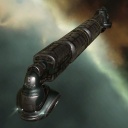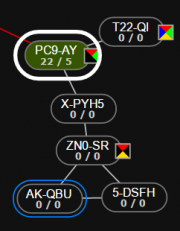Difference between revisions of "User:Thaddeus Kastelanski/Drafts"
| Line 93: | Line 93: | ||
{| | {| | ||
| valign="top" | [[File:Wallet.png|56px]] | | valign="top" | [[File:Wallet.png|56px]] | ||
| − | | valign="middle" | To maximize PI [[Planetary_Industry#Profit.21|profitability]], comparisons should be made between the local and major trade hub markets to determine which goods are selling quickly, or which are selling with the highest profit margin. An item with high demand and lower supply is likely to meet both criteria. Players should account for time or effort for shipping goods to destination markets, which might involve contracting to a shipping service. The third-party site [https://www.adam4eve.eu/pi_rank.php Adam4EVE] is a useful tool to determine which PI commodities currently have the greatest profit margin. Players should note that there is some 'loss' of profit for each additional tier produced, though higher tier materials are ''much'' easier to ship and sell. | + | | valign="middle" | To maximize PI [[Planetary_Industry#Profit.21|profitability]], comparisons should be made between the local and major trade hub markets to determine which goods are selling quickly, or which are selling with the highest profit margin. An item with high demand and lower supply is likely to meet both criteria. Players should account for time or effort for shipping goods to destination markets, which might involve contracting to a shipping service. The third-party site [https://www.adam4eve.eu/pi_rank.php Adam4EVE] is a useful tool to determine which PI commodities currently have the greatest profit margin. '''Players should note that there is some 'loss' of profit for each additional tier produced, though higher tier materials are ''much'' easier to ship and sell.''' |
|} | |} | ||
{| | {| | ||
Revision as of 01:01, 1 June 2022
This article is dedicated to exploring the additional concerns or considerations for conducting Planetary Industry (PI) in Null Security (Nullsec) space. Some statements or conclusions here are valid for other areas of dangerous space, such as High Security (Highsec) space in wartime or Wormholes, though profitability will vary by region of space.
Contents
PI in Dangerous Space
PI encompasses the two activities of extracting planetary resources and processing these raw resources into more advanced products. The amount of resources available for extraction on a planet is influenced by two factors:
- The parent system's Security Level. Lower system security correlates with greater amounts of resources.
- Competing resource extraction on the same planet. More players extracting resources from a given planet correlates with lower amounts of resources.
Comparison with Highsec
The two factors above might lead to the conclusion that PI is not worth the time or effort, in particular if we focus on conducting PI in Highsec space. In Highsec, PI profitability is already diminished by the higher security level, even more so in crowded regions of space.
Null Security (Nullsec) space is also likely to have competing resource extraction activity, but a lower security level means greater resource abundance and higher extraction yields overall. If only examining these two factors, then the logical conclusion is that Nullsec is better for profitability.
Moreover, the majority of Customs Offices in Nullsec are owned by player corporations, which typically means much lower tax rates when moving resources or products to or from a planet. In Highsec, there is an unavoidable 5-10% tax on top of the rate set by the owning corporation, depending on the Customs Code Expertise skill. This skill does not affect Player-Owned Customs Office (POCO) rates in Nullsec.
Tradeoffs
However, Nullsec PI is not without compromises or hidden costs:
- Nullsec is dangerous. Bubbles, stronger rats, and gatecamps are plentiful. CONCORD is not present to intervene in conflicts. Any neutral pilot is a potential aggressor, and many roaming gangs have a habit of returning during peak PvE times.
- Most high-volume trade hubs are found outside of Nullsec. If a player expects to sell PI products on the market, then the goods need to first reach the intended market.
- Certain areas of Nullsec do not have permanent NPC stations. Ships or materials staged in a player-anchored structure are vulnerable to the structure being attacked.
- Because of higher resource extraction yields, PI setups in Nullsec have a higher time cost for transportation if the configuration results in storage filling up quickly.
None of these tradeoffs is insurmountable, as explored in a later section. Even a casual approach to PI in Nullsec is sufficient to fund or supplement day-to-day activities.
Recommendations
Homework
Players considering a new PI operation in Nullsec should take time to understand the region and requirements for initiating and maintaining the operation. A few basic questions might include:
- Which commodities will be extracted or produced?
- Which system(s) are viable for producing these materials? For a general reference, see Good Planets; for the NSC specifically, see the relevant section below.
- Which Command Centers are required, given selected planet(s)? These are sometimes available near the intended destination. Account for extras to cover changing plans or adding additional characters to a larger operation.
- Are materials destined for open market, other industrial activity, a buyback program, or something else?
- What about recurring threats in the region of interest? For the NSC, this would be the entire Y4Y7-Q constellation in Syndicate.
- How much time is reasonable or comfortable for managing an operation? This could be as often as daily, or less than weekly.
Players do not need to have exact answers to these questions, but a reasonable understanding of the steps ahead when planning an operation is helpful for managing PI successfully in a challenging Nullsec environment.
Skills
While there are minimal recommended skills in Planet Management and ship utility for PI in Nullsec, players will find greater success, increased margin of error, and higher survival rates by further advancing core navigation and defensive skills.
The recommended PI skills below will allow single character to run operations on five planets, with the advanced PI skills permitting a sixth planet and advanced (P4) production. The recommended ship skills will enable piloting the standard E-UNI WH/NullSec Epithal fit, and the advanced ship skills will increase both the survivability of the Epithal and the amount of PI materials that it can carry.
Ships
The Epithal
Pilots new to PI in Nullsec should seriously consider only a single ship, the Epithal. This is a specialist Gallente Industrial Ship, similar to the Miasmos, with unique cargo bays for both Planetary Commodities and Command Centers. As there are separate bays for PI concerns, the Epithal can be fitted for maximum survivability at no expense to the ship's utility.
 |
The Epithal is a specialist Gallente Industrial Ship, similar to the Miasmos, with unique cargo bays that can hold very large amounts of planetary commodities and command centers.
|
Other Ships
Pilots should exercise discretion if considering any ship for PI aside from the Epithal in Nullsec.
- Other T1 Haulers. It is strongly recommended that pilots do not use other T1 haulers for regular PI activity. If there is a recurring need to haul extracted resources or final products to or from planets, then the character should be flying an Epithal.
- T2 Haulers. Again, pilots new to Nullsec or PI in Nullsec are urged to stick with the Epithal. However, at a pilot's discretion, a Deep Space Transport might make sense for moving large quantities of extremely valuable product between systems - though multiple smaller shipments in a Epithal would be preferred.
- Freighters. The safest way to move large quantities of goods out of Nullsec is in a Jump Freighter. This is not recommended for the average player, given the enormous skill, time, and investment required. EVE University's NSC often offers a shipping service, which members should seek to use.
- Any racial shuttle. Shuttles are passively immune to bubbles and have a rapid time-to-warp. As some PI activities (importing or exporting from POCOs, for example) involve being present in space and in the same system, a shuttle is a viable option for moving between systems with minimal risk.
Selecting a Product
- Main article: Planetary Commodities
Given the skills and means to start and manage a PI operation, the next key question is: Which goods should be produced? Fortunately, there is no wrong answer, though some choices are more reasonable than others. This decision is closely tied to which system(s) a player prefers for PI, as some planets (and thus some resources) will be unavailable in certain systems.

|
Coolant, Enriched Uranium, Mechanical Parts, Oxygen, and Robotics are all used to produce Oxygen Fuel Blocks. A requirement for reactions and fueling player structures, Fuel Blocks are regularly in-demand in local markets, negating the requirement to ship them to trade hubs. Members of the NSC should note there are respawning ice belts in AK-QBU for obtaining the remaining non-PI materials needed to produce Oxygen Fuel Blocks. |

|
Microfiber Shielding, Polyaramids, and Silicate Glass are P2 products that cannot be manufactured on a single planet because each requires P1 materials to be imported from a separate planet. Assuming the majority of players strive for minimal involvement with PI after initial setup, these three products are generally underproduced, and therefore yield higher profit margins for players willing to put in the extra effort. |

|
All P4 commodities are required for the production of Citadels and Engineering Complexes; therefore, these are generally in-demand and are likely to bring a reasonable return. Advanced commodities require the use of a P2-to-P4 or a P1+P2-to-P4 factory planet to manufacture, which requires more effort than the average capsuleer is willing to put into PI. |

|
To maximize PI profitability, comparisons should be made between the local and major trade hub markets to determine which goods are selling quickly, or which are selling with the highest profit margin. An item with high demand and lower supply is likely to meet both criteria. Players should account for time or effort for shipping goods to destination markets, which might involve contracting to a shipping service. The third-party site Adam4EVE is a useful tool to determine which PI commodities currently have the greatest profit margin. Players should note that there is some 'loss' of profit for each additional tier produced, though higher tier materials are much easier to ship and sell. |
| To maximize PI convenience, pilots within the NSC might avail of the NSC Buyback program as the final 'destination' for goods produced, which can be the simplest way to offload large quantities of PI materials. At time of writing, this program only accepts P2 products or higher. |
Useful resources for exploring PI schematics or product values may be found via references under the main Planetary Industry wiki.
Where to Manufacture?
- Main article: Good Planets
One of, if not the most dangerous places to be in NullSec, is on a Gate. Where possible, it is better to limit all your PI production to one system and ideally a system that also has a Station or a Citadel blue to the Uni. The tables below show all the planets and systems within the NSC backpocket and also what PI commodities can be produced completed within each system. One other factor to be aware of is the further into the pocket you go, the safer you should be due to the increased warning of Neutrals entering PC9-AY. Again, you are never safe in NullSec and should not get complacent. Neutrals do log off in the backpocket and there are often wormholes that bring visitors. Always pay attention to local and dock up/go safe if you see anyone not blue.
Here you can find a screenshot of the resource bars of every planet in the NSC And here you can find abundances for all the P0 materials in every planet in the NSC in percents
